I just looked a little deeper into some rainbow geometry and discovered that this challenge could be a lot harder than I first imagined. But for those of you who have no idea what I’m talking about, here’s a little history –
The Facebook Quiz
This all started with one of the little quizzes I put on my personal Facebook page from time to time. This one went like this:
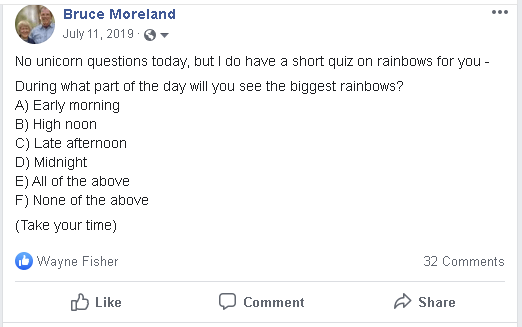
A friend, John Gilbert, responded:
Bogus question, Bruce. Answers D, E and F are unicorn answers. I’ll take B, high noon, for 500.
John Gilbert’s 4:56 pm Facebook comment on July 12, 2019 to above post
to which I responded,
You started well but still wound up with the fourth-best answer (just behind D)….
My 3:31 am response on July 22, 2019
Then:

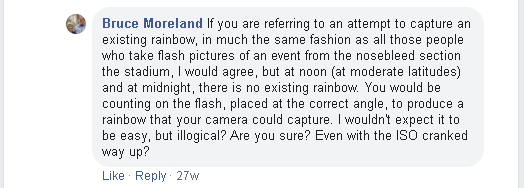


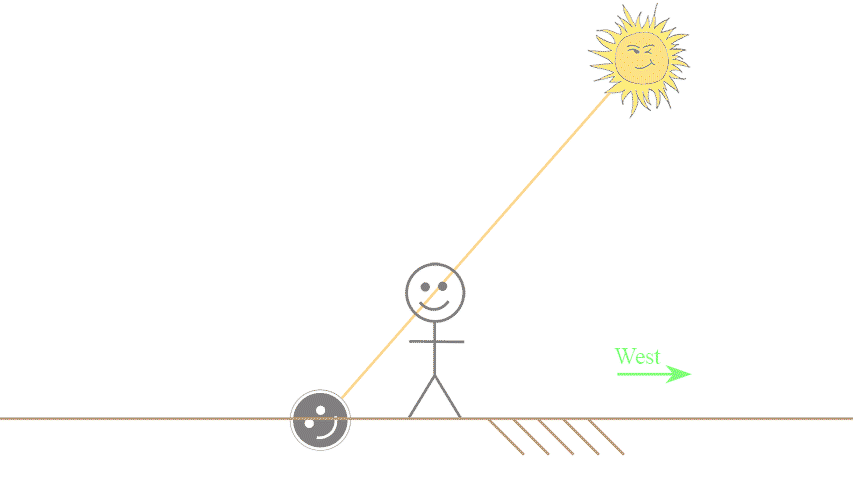
Just to be clear, this animation is for illustration purposes only. In real life, if you were standing to the side at a distance watching your friend admiring his rainbow, you would not be able to measure that 42° angle because you would not be able to see his rainbow. But if you looked to your left, directly away from the sun, you would see your own rainbow. Rainbows don’t have a “side view”. But if you could see his rainbow, you would see that it was not a circle in one perpendicular plane, but actually a part of a cone with his eye being the vertex (or pointy end).
The Contest
To speed things up, I then asked our local Kendall Camera Club for help by creating a contest for the best nighttime rainbow picture. I am now extending that contest to all of my readers. Here are the rules:
Contest Rules
- I’ll give the equivalent of a six-pack of your favorite brew (within reason) for the best picture of a rainbow at night. I said six-pack equivalent because a corresponding discount for any of the products or services of Bee Happy Graphics (see our Products and/or Services pages) may be substituted at your request.
- The contest will run at least another month but may continue until we get a chance to get our own rainbow pictures (which will not be part of this contest) or until I give up all hope of completing this quest. If there are not enough entries at the end of the contest, there will be no prize.
- You can enter your image by emailing the file to admin@BeeHappyGraphics.com.
- Composition does count. Photos of real rainbows will be given precedence, but just in case I overstated the possibility of that occurring, we will accept “Photoshopped” rainbows.
- I will announce the close of the competition and the beginning of the voting process in a comment to this blog post. I will explain the voting process in that same comment.
- At least three weeks after the announcement from Rule 5 above, I will announce a winner. If any entry has three or more votes, the winner will be the one with the most votes. If no entry has that many votes, I will take an informal survey among my closest family and friends and pick the winner. The decision of the judges (as defined above) is final. This prize may be combined with other promotions.
- Since this is a photo contest, I should mention that the photographer retains all rights to their image. We get to use your image only to run and publish the results of this contest.
So far, there have been no entries.
The Physics
As I mentioned at the beginning of this article, the geometry doesn’t look good.
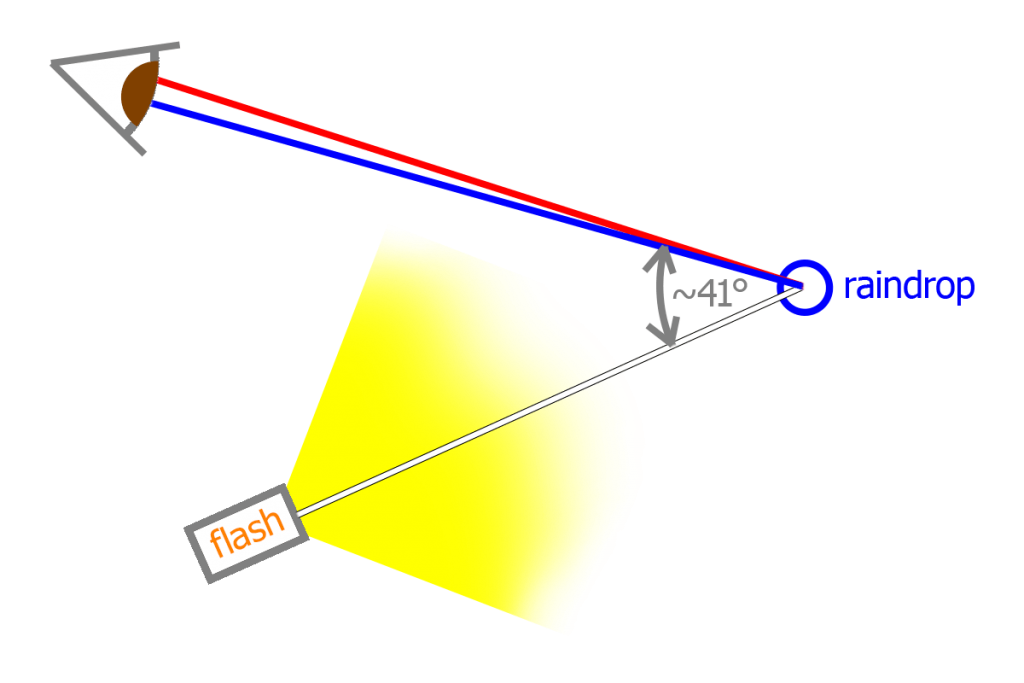
Figure 1 shows the angle that a light ray bounces off of a single raindrop. In Figure 2 (which is a view looking down, with the blue-hashed region being a rain cloud), one can see that as the sun’s rays all come in as parallel lines from the same direction, the five representative raindrops, and all others from which the blue light rays bounce at the same angle into the observer’s eye are all along the same line of sight, and therefore all reinforce each other. A single raindrop doesn’t reflect a lot of light, and it takes the light of a lot of raindrops to make the rainbow visible. Similarly, the raindrops reflecting red light into the eye from a slightly different angle form along a slightly different line of sight and also reinforce each other.
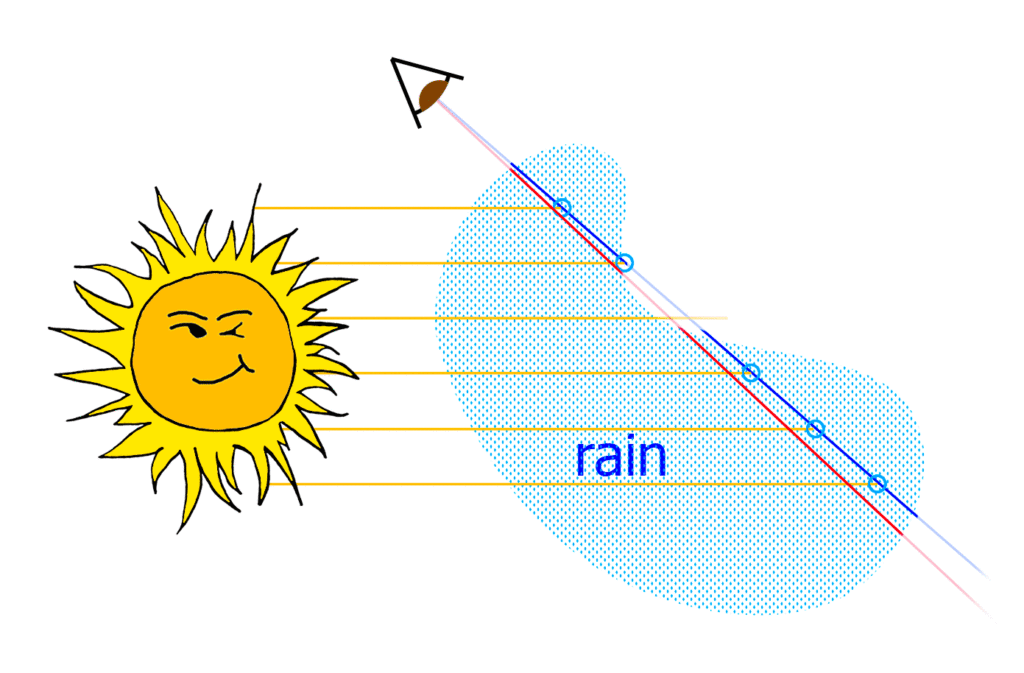
The Problem
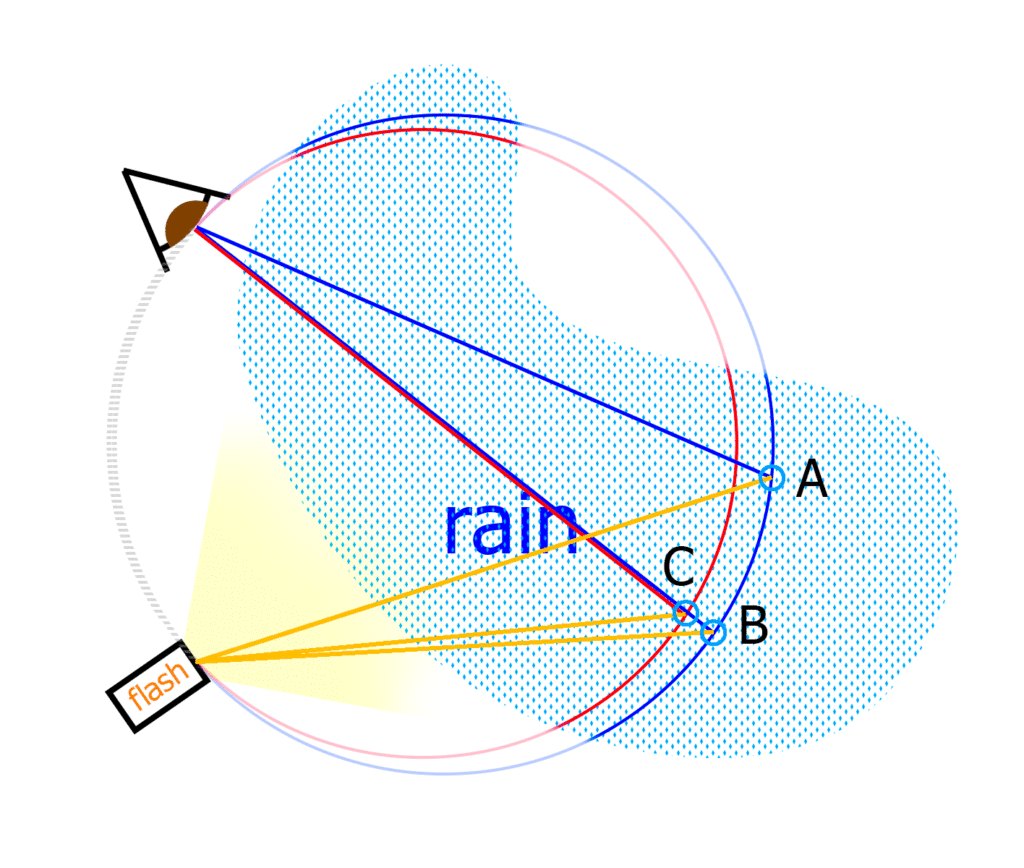
But using flash, the geometry is different; the light source and the eye can now be represented by single points. But unless you were the navigator of a Coast Guard buoy tender or something, you may have forgotten a lesson from high school geometry; that the set of all points for which the angle between those two objects is the same defines a circle, not a line. In Figure 3, the angle between the flash and the eye is the same for Representative Raindrops A and B and all other dark blue points on the outer circle (there is no rain along the pale blue segments of that circle). Unfortunately, each point on that circle is along a different line of sight from the observer, so the light rays do NOT accumulate in the eye. To make matters worse, the red light reflected from Representative Raindrop C (on the circle of red light) IS along the same line of sight as the blue light from Representative Raindrop B (and the other colors of the spectrum from raindrops directly between them), which tend to cancel out into white light. This means you will see no rainbow.
Where Does That Leave Us
The original purpose of this article was to throw in the towel and admit defeat, but as I was getting the materials together, I’ve already come up with a couple of new ideas that need to be explored. But the busiest part of our art festival season is now upon us, and the rainy season doesn’t start in South Florida until around June, so this is not the rainbow of promise but one of hope (and if you have a photograph of a nighttime rainbow, please send it). Stay tuned. Thanks.
Leave a Reply